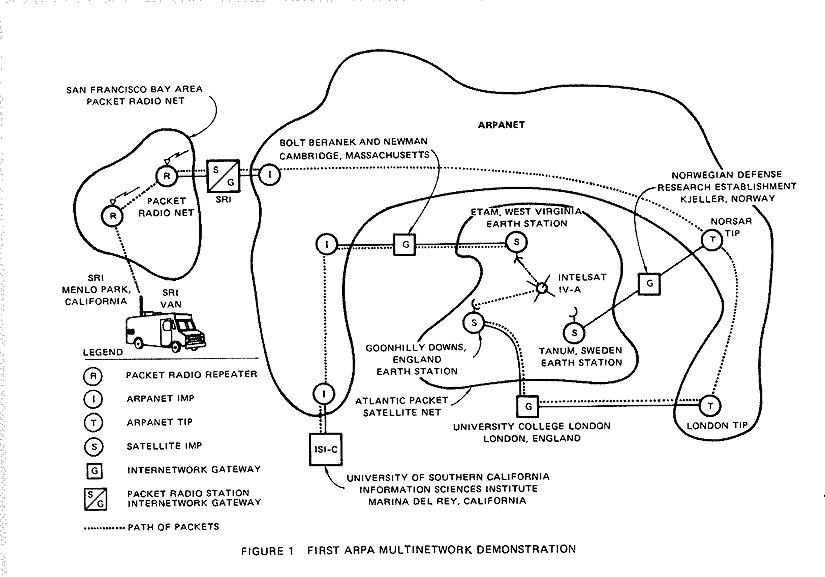what is the internet?
This class we will look at what the internet is, where it came from, and the ways in which it operates today.

web archaeology using the Wayback Machine
- how did it change over time?
- what kind of changes in technology/culture do these reflect?
- how do you think the intentions of the design evolved - were they effective?
- how did the changes affect your interactions, perceptions, and the online landscape?
lecture: what is the internet?
it’s part of a long history that connects communication, war and the planet
Ancient Greek fire signals and Agamemnon (330BC)
Lewis Fry Richardson, the original cloud (1921)
AT&T, Electric Skyway (1951)
the internet is just other computers
the server-client model
but increasingly, some of those computers are really, really big
much of what we access is hosted on server farms like Google’s
beginning in the Cold War, decentralization means resilience
ARPANET network map
the SRI Packet Radio Van, the first TCP/IP transmission (1977)
Paul Baran, Decentralized Network Diagram (1964)
Physarum Polycephalum, the many-headed slime mould
“While many have debated the origins of the Internet, it’s clear that in many ways it was built to withstand nuclear attack. The Net was designed as a solution to the vulnerability of the military’s centralized system of command and control during the late 1950’s and beyond. For, the argument goes, if there are no central command centers, then there can be no central targets and overall damage is reduced.” Alex Galloway, Protocol, 2001
while decentralized transport networks have many ways to get from A to B
international flight paths map
US highway system
and yet the internet can be very fragile
a Georgian woman accidentally cuts off the internet for Armenia
Pakistan accidentally blocks youtube for half the planet
The myth persists that the Net was built to withstand the blast of an atomic bomb. But that was the military-run Arpanet of the 1970s, not the corporate-run Internet of today. “What’s basically wrong is we are centralized,” explains Dr. Peter Salus, Internet historian and author of Casting the Net. “We have violated the constraints that the Department of Defense had in 1967.” Wired in 1997
the network functions within (and often against) geographic and political borders
Adobe shuts down cloud services in Venezuela following US trade ban (2019)
US researchers concerned that American traffic is rerouted through Belarus (2013)
Wikileaks diplomatic cables release (2010)
The US thinks TikTok could be a national security threat (2019)
Tim Cook defends Apple’s removal of Hong Kong mapping app (2019)
a networked counterculture arose alongside military designs
Ant Farm, Truckstop Network (1971)
Stewart Brand, the Whole Earth Catalog (1968)
a sense of freedom through technology which was soon co-opted by commerce
Apple macintosh commercial (1984)
creating an cultural ideology that still underpins Silicon Valley today
Richard Barbrook and Andy Cameron, The Californian Ideology
materially, the internet is a series of tubes
global submarine cables (timelapse)
though it may one day look more like a swarm in the skies
SpaceX Starlink releases 60 internet satellites (2019)
Facebook tried to create a globe-spanning internet of solar-powered drones
we talk about the internet, but there are many internets
the Russian Internet
the Chinese internet
deep packet inspection
Cuba and el paquete semanal, an example of a sneakernet
the Egyptian “killswitch”
Louise Druhle, Critical Atlas of the Internet
key technologies
an incredibly 90s animation of how the internet works
Transport Control Protocol (TCP/IP)
Domain Name System (DNS)
Hypertext Transport Protocol (HTTP)
Tim Berners-Lee, the first web server at CERN (1991)